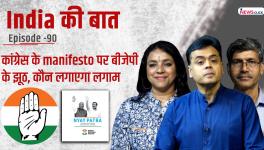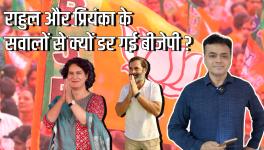Seeing Reason in the CPI(M)’s Politics

The decision of the Central Committee of the largest Left party in India - the Communist Party of India (Marxist), or the CPI(M) - to refrain from any alliance or understanding with the Congress party has led to many critical responses. A number of secular and progressive-minded people have taken exception to the CPI(M)’s decision. Many of them have argued in favour of an umbrella-electoral alliance of non-BJP parties to defeat the Bharatiya Janata Party (BJP) in the 2019 elections to the Parliament. The refusal of the CPI(M) to join hands with the Congress is proof, they argue, that it is just a “B-team” of the BJP.
These views, though may be well-meaning, are misguided and betray a poor understanding of the complex realities of Indian politics in the times of Hindutva. In my opinion, an alternative to the BJP’s rule can not simply be a return to a scenario prior to the BJP’s rule, which was singularly guilty of sowing the seeds for the BJP’s rise in the Indian society and polity.
To begin with, the strength of the Left in India, particularly the CPI(M), has never been in the electoral sphere. The Left is electorally powerful in only three States. Of course, in these States, the Left has shown that an alternative development trajectory is indeed possible. If we look outside these States, the Left simply lacks any pan-Indian electoral strength. Yet, the importance of Left politics in the country’s public domain has never been on the wane. Whenever there is an attack on the liberal values of our society or on the livelihoods of people, it is the Left that people expect to be on the vanguard. This phenomenon is because of the remarkable ability of the Left parties, and their mass organisations of farmers, workers, students and women, to mobilise people and mount powerful movements for pro-people policies, and against anti-people policies of the ruling classes.
In India, this ruling class is constituted by the BJP and the Congress. They, together, represent the rural and the urban rich. Crony capitalism has been a hallmark of both the Congress and BJP governments. It is their combined interest to move India towards imperialist-driven globalisation, liberalisation and a free market economy. The contemporary agrarian crisis in India is a direct fall-out of the Congress party’s neoliberal agenda in agriculture, which the BJP government has taken forward. It is the Congress’s agenda of privatisation and fund-squeeze for higher education that the BJP government has been gladly pursuing. The Orwellian Aadhaar was a brain-child of the Congress. The two parties have, historically, presided over regimes that have entrenched upper caste groups in their pursuit of domination over lower caste groups. They have together created a fertile ground in Indian society where science and rational thinking are dumped in favour of obscurantism and superstitions.
Of course, the BJP is a bigger danger than the Congress. The BJP is also a communal right-wing entity that aims at converting secular India into a Hindu Rashtra. Hence, the argument is put forward that the “neoliberal, but secular” Congress and the “non-neoliberal and secular” Left could ally with each other to keep the common enemy - the “neoliberal and communal” BJP - out of power. In this regard, a number of commentators have pointed to the post-election developments of 2004 as a useful guide. However, this may be a simplistic portrayal of a far more complex political reality in Indian politics. Experience shows that electoral adjustments may temporarily keep the BJP out of power, but they distract attention from the more fundamental task of transforming how people’s consciousness is moulded by communal ideologies. In a recent speech at the Mumbai Collective in Mumbai, Prakash Karat had elaborated on this point in detail:
“We have seen that the non-BJP, or the non-Hindutva political forces in this country, ranging from the secular Right to the Left in India, have [in the past] sought to fight off the Hindutva forces primarily through electoral politics. We did that successfully in the year 2004, when electoral tactics were worked out to oust the Vajpayee government from office and defeat the BJP. But despite the electoral defeat of the BJP, there was no real erosion or weakening of Hindutva forces. They suffered a setback, but their bases were intact…That is because Hindutva politics is something that is fashioned and engineered by the Rashtriya Swayamsevak Sangh (RSS). And the RSS works round the clock, 24*7, in our society in terms of spreading the Hindutva ideology…it is a political project of the RSS, the ultimate aim being to establish a Hindu Rashtra. So, while they suffered electoral defeat from time to time, because of effective political and electoral measures adopted by the secular opposition/regional parties, their consistent work in different spheres of our society never ceased and they continued to gain ground. And we have not tackled that seriously.”
This takes us to two questions: first, does the Congress have a meaningful role in effectively defeating the ideology of Hindutva? Second, whether a singular attention to electoral adjustments distracts the Left from the more fundamental task of building genuine people’s movements against communalism and neoliberalism?
First, if there is a sure “B-team” of the BJP in India, it has been the Congress. History is replete with evidence on this ground. It was Rajiv Gandhi who first opened the doors of the so-called Ram temple in Ayodhya’s Babri Masjid and promised a Ram Rajya to the people. The Babri Masjid was demolished in 1992 under the aegis of a Congress government. Countless communal riots have been engineered across the country with incumbent Congress governments watching in silence. The UPA-1 government had appointed the Rajinder Sacchar Commission to enquire into the economic backwardness of Muslims. Some hesitant policy actions followed, but when the Congress lost the 2014 Parliament elections, its General Secretary A. K. Antony attributed the loss to the party’s appeasement of minorities, which alienated the majority community.
After 2014, the Congress has once again returned to its time-tested “soft-Hindutva” plank. This was unmistakably visible during the Gujarat elections of 2017, in which the party’s spokespersons introduced temple-hopper Rahul Gandhi as a “shiv bhakt” and “janeudhaari brahmin”. In the forthcoming Karnataka assembly polls, report suggest, the Congress is getting ready to repeat the “temple strategy” attempted in Gujarat. In Maharashtra, Congress leaders are busy setting up “sadhu-sant samaj” cells to influence Hindu monks and sages. More recently, they have publicly invited the fascistic Shiv Sena for an alliance to bring the BJP down from power. The Congress party has never had an unambiguous policy on cow slaughter. Many State-level leaders of the Congress are strong votaries of the ban on cow slaughter and the beef ban. Congress leaders from Haryana have been some of the strongest supporters of the extra-constitutional khap panchayats. It is not for nothing then that hordes of senior leaders of the Congress - Rita Bahuguna, S. M. Krishna, Himanta Biswa Sarma, Satpal Maharaj, Jagadambika Pal and Narayan Rane among others - have jumped ship overnight to transform into leaders of the BJP. To top it all, in the Tripura assembly polls of 2018, all the sitting Congress MLAs of the current assembly are contesting as BJP candidates.
The Congress, then, is a poor candidate to lead the socio-cultural offensive against the communal Right. Arun Jaitley was probably right in his comment soon after the Gujarat assembly elections: “if an original is available, why would anyone prefer a clone?”
Secondly, the CPI(M)’s emerging strategy to counter the BJP moves away from temporary electoral adjustments, as have been tried in the past, towards more substantive building up of people’s movements against both communalism and neoliberalism. Let’s get the fact right. There has been a secular decline in the electoral support for the Left parties over the years, particularly in States outside its strongholds. One of the reasons for this decline has been the electoral alliances stitched together, year after year, with both the Congress and many regional parties. A casualty in the midst of these electoral forays has been the independent struggles of the Left. The decision of the CPI(M)’s Central Committee appears to correct this anomaly and focus on building independent struggles of the Left across the country. The work has already begun. The two largest farmer’s struggles of recent times - in Maharashtra and Rajasthan - were spearheaded by the All India Kisan Sabha, a CPI(M)-led organisation of farmers. The Left’s trade unions have been in the leadership of national strikes and agitations of the workers, the largest being the maha padav in New Delhi of November 2017. Left-led student organisations have been holding the fort in campuses across India against the heinous attacks on higher education by the Narendra Modi government.
The importance of a sustained build-up of such movements from below against Hindutva politics on the one hand, and neoliberal policies on the other, is unfortunately not appreciated by some in the progressive circles. It is only such a comprehensive struggle that would ultimately alienate the RSS and its pet themes from the public sphere. In his Mumbai lecture, Prakash Karat had elaborated on this point too:
“After three-and-a-half years of the Modi regime, all of us are seriously grappling with the question of how to counter this challenge; how do we overcome this political challenge of the Hindutva forces…There is a natural and popular urge that all of you should get together and defeat the BJP in electoral terms. But I believe that this is putting the cart before the horse…There is still insufficient recognition that the advance made by Hindutva politics and ideology over substantial sections of our people cannot be undone purely through electoral battle and electoral struggle. We have to have a more comprehensive plan of action. Here, the first thing is to recognise that large sections of the people, including the working people - the working class, the peasantry, the rural poor, the urban poor - all those should be the basis for our fight against the Hindutva forces. These people have been won over to the other side of the camp of the Hindutva forces. In order to fight the Hindutva forces effectively, we have to win the battle for the minds and interests of these sections of people. The shrinking of the space for the secular democratic forces is underlined by this reality at the ground level…”
In the contemporary situation where Hindutva and neoliberalism are inseparably inter-twined, as under Narendra Modi’s BJP, the alternative too has to be equally encompassing. Alliances or understandings with elements of the so-called “secular Right” would not only diminish the legitimacy of such an arrangement in the minds of people. It would also deliver a major setback to the cause of a genuine Left and democratic alternative to the Congress and the BJP. It is hoped that short-sighted commentators who slight the Left have a rethink on their position and see reason in the CPI(M)’s stance.
Disclaimer: The views expressed here are the author's personal views, and do not necessarily represent the views of Newsclick.
Get the latest reports & analysis with people's perspective on Protests, movements & deep analytical videos, discussions of the current affairs in your Telegram app. Subscribe to NewsClick's Telegram channel & get Real-Time updates on stories, as they get published on our website.























